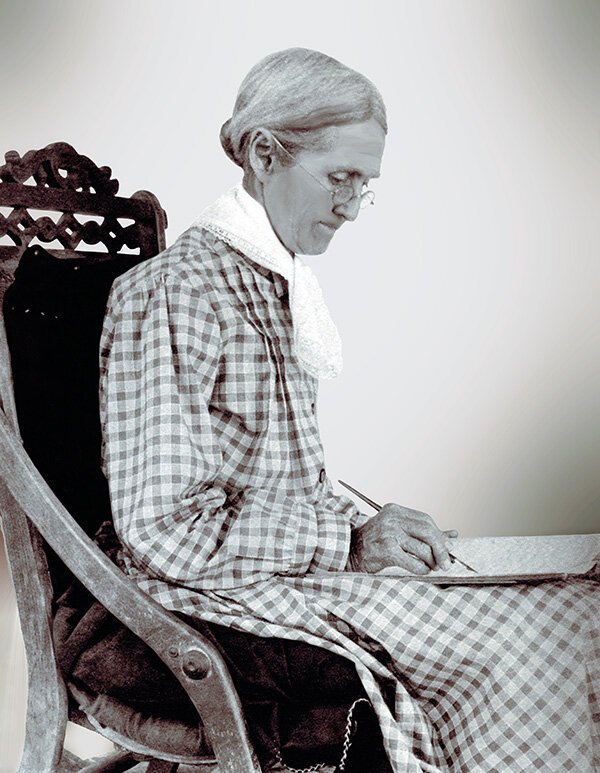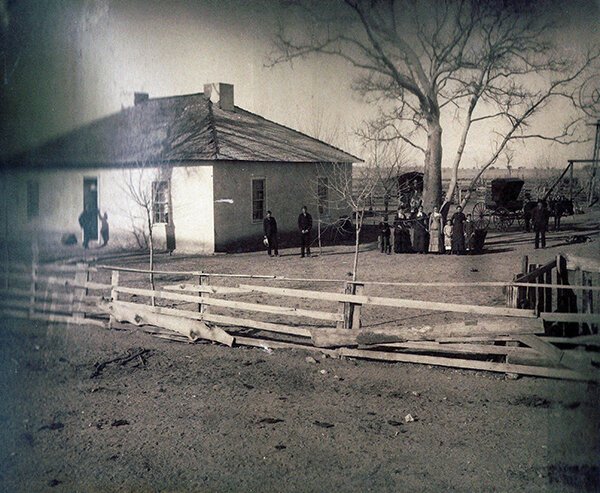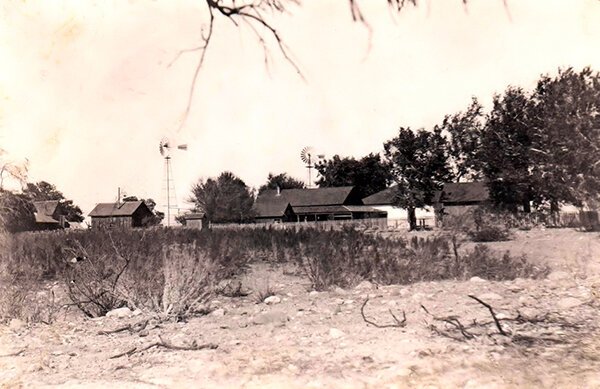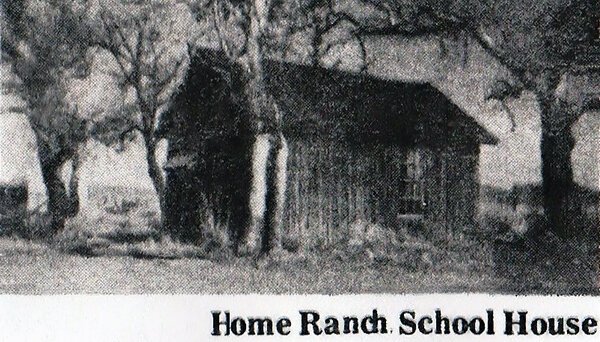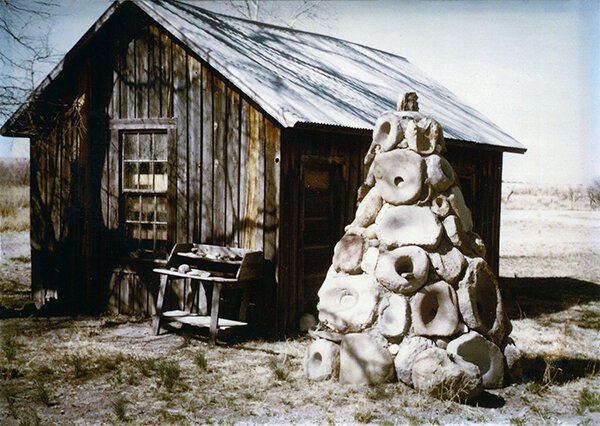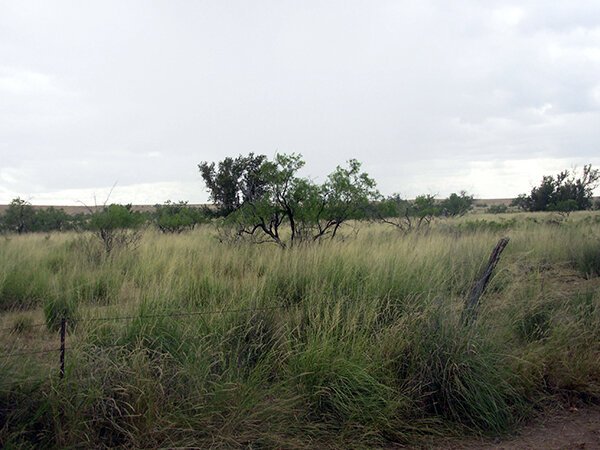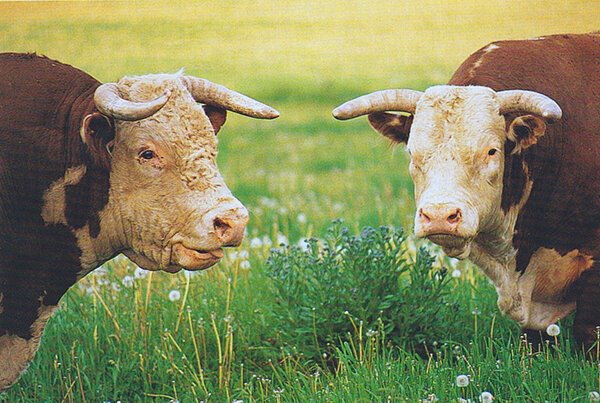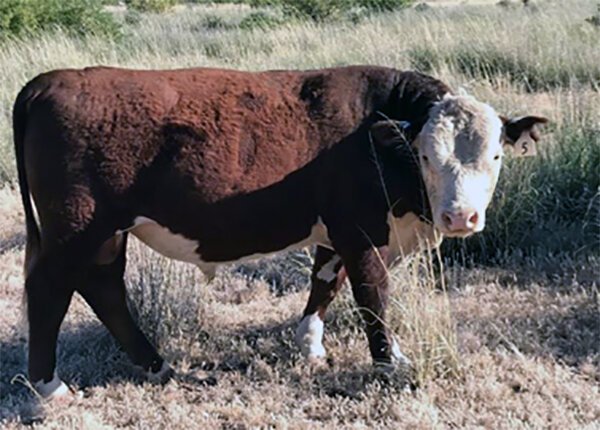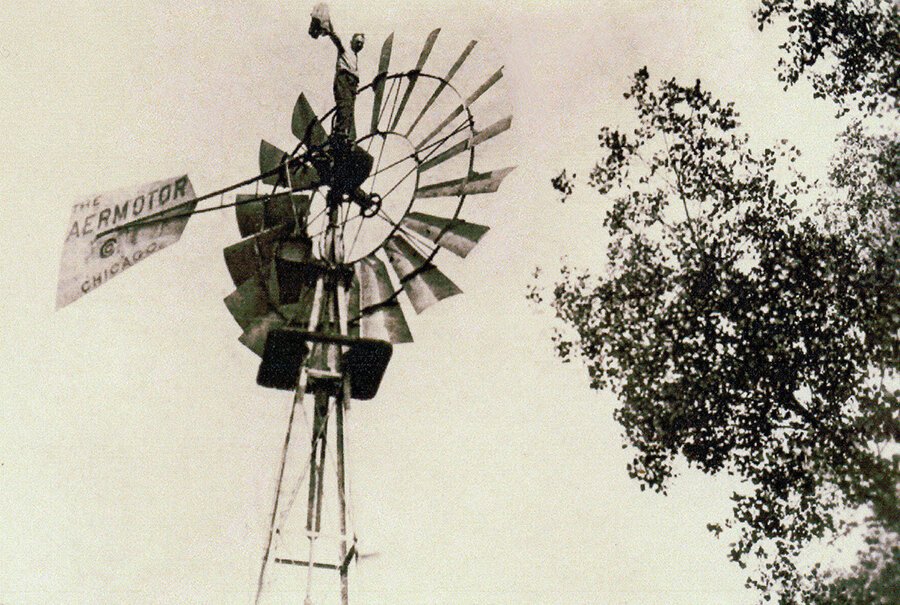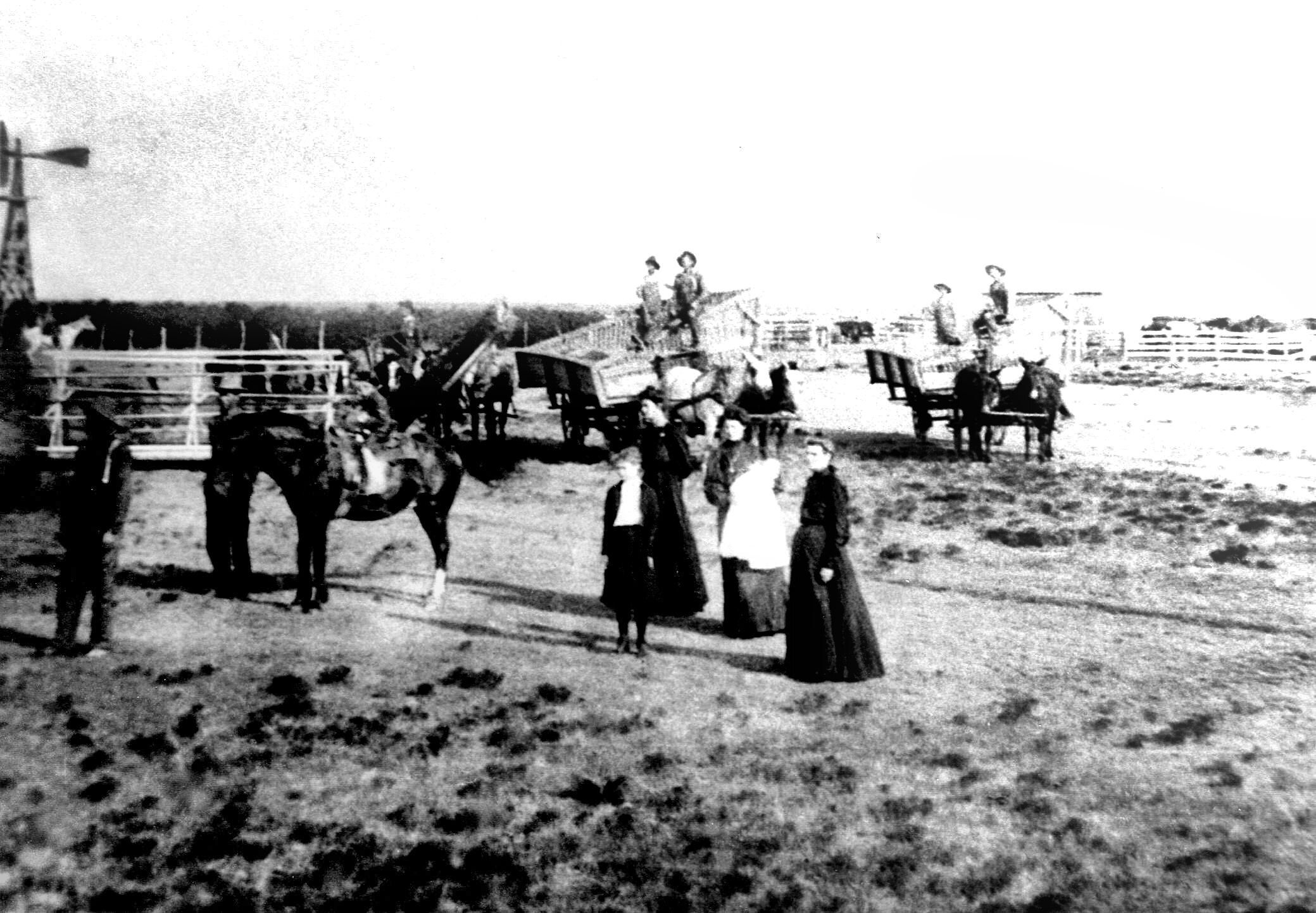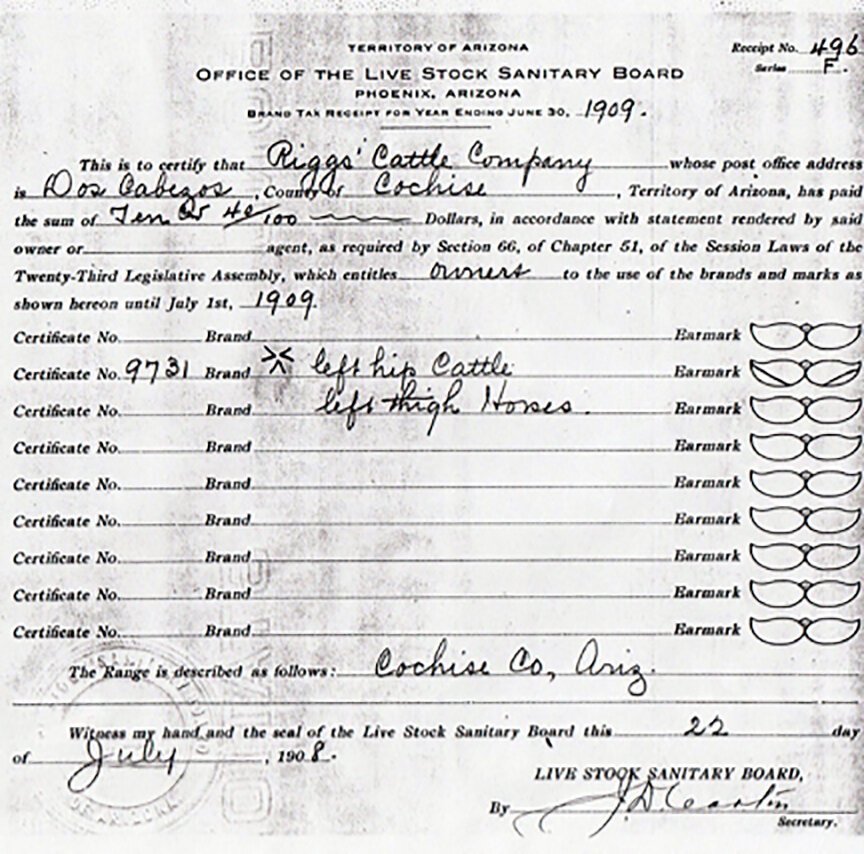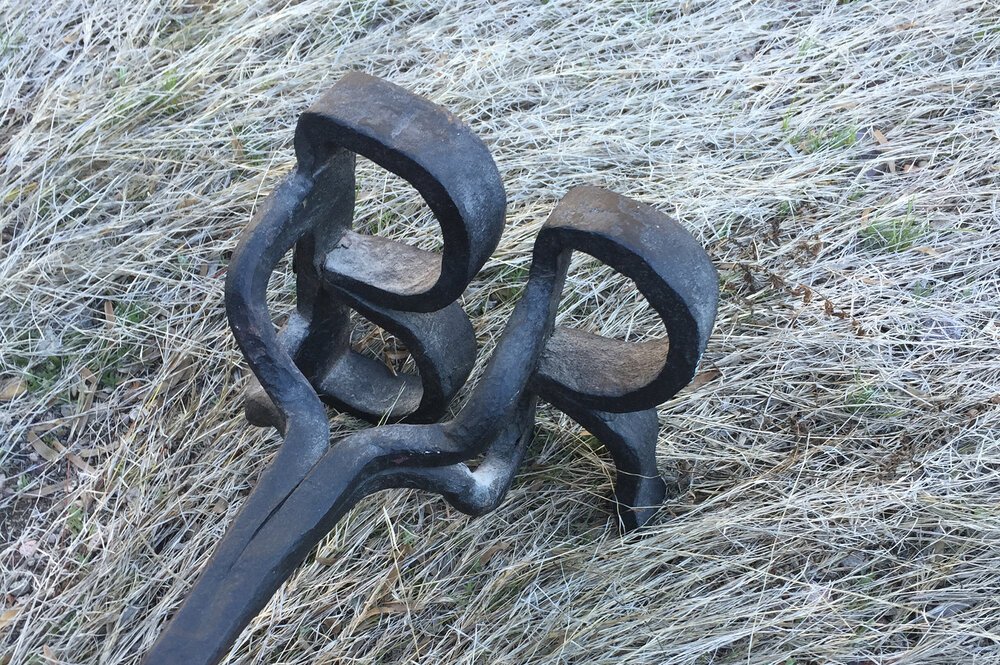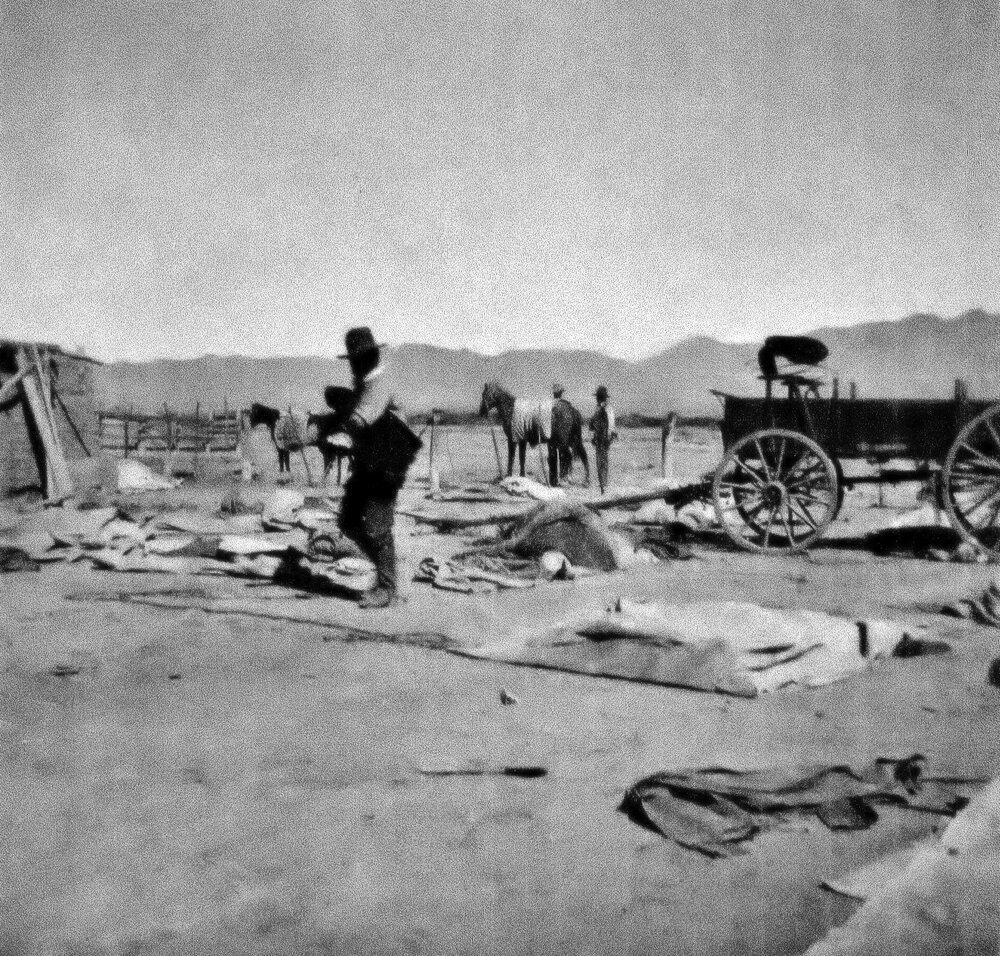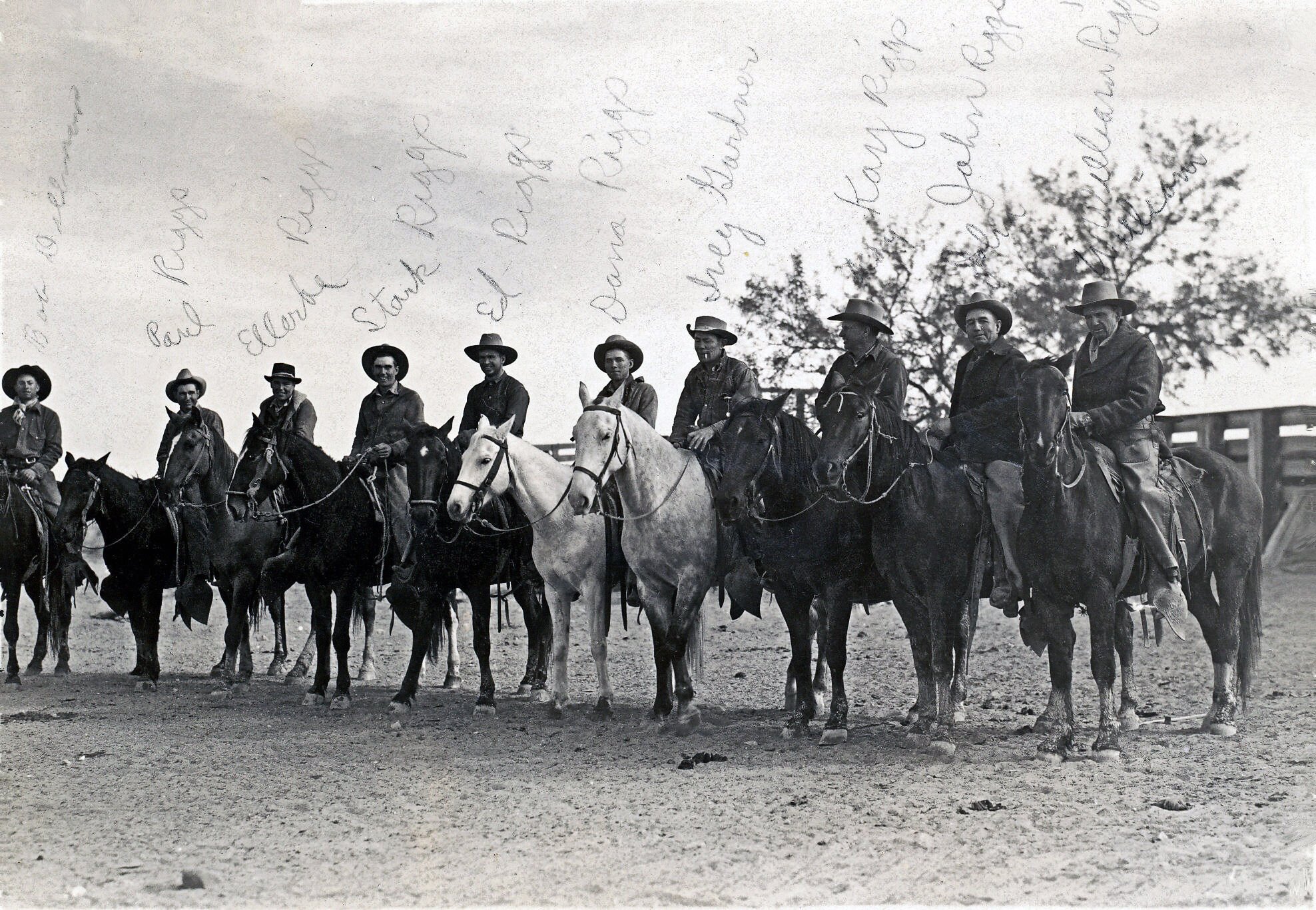MARY ELIZABETH RIGGS: MY STORY (CONTINUED)
PAGE 2 OF 3
MARY ELIZABETH (ROBBINS) RIGGS
page 2 of 3
RIGGS HOME RANCH
By October 1879 the water was giving out in Emigrant Canyon, forcing our family to move. The men had been exploring the country and a big spring had been found in the Sulphur Springs valley. We went through Apache Pass and out into the valley a few miles and made camp again. Even after we got to the Sulphur Springs valley we continued to live in the tents and wagons. As time went by, we could tell that the water was getting lower here also, so a search was made for a permanent water source. About a mile east of where we were camped, in the mouth of Pinery canyon, at its juncture with Bonita canyon, water was found, a well was dug near some large sycamore trees and a permanent water source was developed. A system called a “horse-power” was rigged up that used a mule and two 40-gallon barrels. The mule was connected by harness to a long pole. He would walk around in a circle. As one barrel would come up full of water, which was dumped into the tank, the other would go down empty, then the process would be reversed. This “Horse-power” acted as a pump to raise the water from the well to be emptied into stock tanks to water the cattle.
FAMILY BY TANK AND WINDMILL WITH THE HORSE POWER PUMP
(Left to right: B.K. Riggs, unknown, Brannick Benjamin Riggs, unknown, Brannick Riggs, unknown, Mary Elizabeth, Rhoda Riggs and John Casey Riggs)
In the spring of 1880, a house was built near the well and the sycamore trees and our family’s “Home Ranch” was established. Our house was built of 18-inch adobe walls that were two adobes deep for security against Indian attack.
Adobes are good building material for the desert because the materials for making adobe are readily available. The thickness of the walls insulates against the heat in the summer keeping the inside cool and retain the warmth in the winter making it warmer inside. Adobes are made by mixing dirt that is fairly high in clay content, straw and water together. This mixture is put into open wooden molds. The brick is then turned out onto the ground to be dried by the sun. Walls of a building are made by stacking the adobe bricks and fastening them together with mortar made of the same dirt and water without the straw. The outside of the building is then plastered over with the same kind of mortar mixture to keep it from washing away over time. In addition to its heavy walls, the timbers used in its construction were cut out of the nearby mountain forests.
The house consisted of two rooms on each side (four rooms in all) with a wide breezeway between, extending the full width of the building. There was a fireplace in each room to provide heat in the winter. A porch ran along the length of the front of the house. This was known as a “Dog-run” style house. The porch along the front and the breezeway that ran through the center drew a breeze through it and provided shade and cool air during the heat of summer. My kitchen and dining room were built at a 90-degree angle, separate from the rest of the house. The kitchen being separate helped control the heat in the rest of the house in the summer. Later the two buildings were joined.
ORIGINAL RIGGS HOME RANCH HOUSE (VIEW LOOKING NORTHEAST)
RIGGS HOME RANCH HOUSE WITH COOK HOUSE ADDITION (VIEW LOOKING EAST)
ORIGINAL RIGGS HOME RANCH HOUSE (VIEW LOOKING SOUTHEAST)
RIGGS HOME RANCH HOUSE WITH COOK HOUSE ADDITION, BARNS AND OUT BUILDINGS (VIEW LOOKING WEST)
In 1880, by the time we had reached our journey’s end and our “Home Ranch” was well under way, Mr. Riggs was 52 years old and I was 42. T.J., had stayed in Colorado when we left, but joined us later, was 23 years old, Rhoda 21, William 19, Martha 15, B.B. 13, J.J. 10, Mary 8, J.C. 6, Lucy 4 and B.K. 1. It took some time for Mr. Riggs and the boys to give up their dream of going to California. Our “Home Ranch” was developing nicely at the base of the Chiricahua Mountains, but Mr. Riggs was talking again about pulling up stakes and heading west. Finally, I just told him, “Mr. Riggs, you and the boys can go to California if you want but the girls and I are staying right here.” So, needless to say, we stayed and we have never regretted the decision. We had moved so many times I felt that it was time to settle down and build our dream right where we were. As Home Ranch was developed and more improvements made, it became the center place for our family and we came to realize we had found and were already living in the “El Dorado” we had been seeking.
On 2 Aug 1884 our last child, Edith Bessie, was born at Home Ranch. She was not to remain with us long. On 9 Aug 1885 she died of summer complaint. We buried her in a family cemetery which we started on a hill not far from the spring where we first camped in the Sulphur Springs valley. Edith Bessie was the second person to be buried in the family cemetery, the first person being her nephew, Frank Thomas Riggs, son of T.J. and Eula Lee, who died 12 days before, also of summer complaint. Summer Complaint is a bacterial infection that causes severe diarrhea in young children. It is caused by bacteria in spoiled food or milk.
MAINTENANCE OF HOME RANCH BUILDINGS
As with any home age, weather and natural disasters can take their toll on the structure. Over time maintenance was needed and improvements to the home were made.
“May the 3rd 1887 we had a Severe Earth quake
Some thing unknown To Arizonians
it liked to Scared the people to death
it cracked our house
18 Feb 1902 we are loocking for the house to crumble down on us
hope it will not trouble
19 July 1903 Thos an the boyes put a new floar a Sink in the Stove room
piped the watter in
1 Dec 1903 Thos is fixing our house an putting on a poarch in front
A New year 1904
January the 1 Thos hallingfloaring from Willcox for the new kitchen
11 Jan 1904 Thos an John Started to build a new kitchen
13 Jan 1904 Mr TB helped with the new kitch
16 Jan 1904 all the neighbors helped pit the Shingles on the new house
13 Feb 1904 had to prop the old kitchen
2 Mar 1904 Thomas went to Willcox for Shingles to finish the kitchen
7 Mar 1904 we are Still mooving
14 Mar 1904 pulled the old kitchen down
21 Mar 1904 Savary is halling the old kitchen adobas off
Thos is fixing our house an puting on a poarch in front”
NEIGHBORHOOD SCHOOLS and HIGHER EDUCATION
Education was important to our family. We both could read and write and felt it was important that our children receive what education could be provided for them. My father was a teacher by profession and had impressed on me the importance of having an education.
When the family lived in Bandera County Texas, Rhoda Elizabeth, Margaret Ann, William C., John Roland, (children of John and Jane Riggs, who had been killed by the Indians) and our children, T.J., Rhoda and William M. all attended the local school.
After the family moved to Las Animas County, Colorado, a school house was built and we started a school at home for all the children in the area. At least an eighth-grade education was the goal for the students. It didn’t matter how old you were, you attended classes when-ever you could. The school year was different than school years have become in later years. The children were needed in the fields and helping with other endeavors around the home. This required that school didn’t begin until usually October, after harvest. It also required that school was let out in April so especially the bigger boys could help prepare the fields for planting. In our family, it was necessary for the older boys to help making shingles in the sawmill until the weather prevented that work. Occasionally when a big ordered was received, the school was closed and the older boys worked in the sawmill. The young men and girls went to school for as long as they could regardless of their age. It was important that they get as much education as possible. In Colorado there were two teachers, a Mr. Steven D. Stout, an older gentleman that taught only one year and a Mr. James William Wolf.
When the Home ranch was established, the closest school was in Dos Cabesas, about 15 miles from Home Ranch. Rhoda, William, Martha and Brannick B attended that school until a school house was built in the yard. In 1881, after our family home was built near the mouth of Pinery Canyon of the Chiricahua Mountains in Cochise County, a one room schoolhouse was built in our front yard and a teacher hired to teach our children, and any other children of the neighboring ranches. The school was a small wooden structure. This building has stood for many years as a monument to our family’s pursuit of Education. Again, it didn’t matter how old you were, you attended classes when-ever you could. T. B. Stark was the first teacher at this school. Ida Lillie Berry was the next teacher. T.J.’s wife, Eula Lee Murry, also taught in the Home Ranch school, as did Ed Riggs wife, Lillian Erickson.
HOME RANCH SCHOOL HOUSE
In 1881, after our family home was built, a schoolhouse was built in our front yard and a teacher hired to teach the Riggs children, and any other children of the neighboring ranches. Until the school house was built William, Rhoda and Martha attended school in Dos Cabezas. The school was a small wooden structure. This building has stood for many years as a monument to our family’s pursuit of Education.
SCHOOL HOUSE AND METATE MONUMENT AT HOME RANCH
In 1887 the El Dorado School District No. 16 was formed by Cochise County. As our neighborhood grew, the school house at Home Ranch became too small to meet the needs of the neighborhood children. The District started building a new School house in January 1900 and it was finished in December 1900 and is known as the El Dorado School. Restrooms were added to the school in 1947.
EL DORADO SCHOOL BUILT IN 1900
EL DORADO SCHOOL BUILT IN 1900
EL DORADO SCHOOL (PHOTOGRAPH TAKEN IN SEPTEMBER 2013)
The school became the social center for the neighboring ranchers and their families. There were programs, neighborhood Christmas trees, dances, Red Cross meetings, Literary Readings, even Church meetings at times, held at the school. Each Arbor Day new trees would be planted by the children around the school. Over the years we had many teachers for our school. Ida Lilly Berry, T.B. Stark, Lillian Erickson and Eula Lee Murry were all teachers that later became members of our family.
In 1879 when our family moved to the Sulphur Springs valley and started our Home Ranch, we were living in Pima County, Arizona Territory. Later in 1880, Cochise County was formed from that part of Pima County where our family lived.
VALPARAISO NORMAL SCHOOL 1870, VALPARAISO, IN
As the children reached the point that they needed to go elsewhere to complete their education, arrangements were made. Several of them went to schools in California for a time. Four of the boys, 2 grandsons and two of the girls went to school at Valparaiso Normal in Valparaiso, Indiana.
Valparaiso Normal School was founded by methodists in 1859 as an institution pioneering coeducation. The Valparaiso Male and Female College was founded as one of the nation’s first coeducational colleges.
Brannick Benjamin started school at Valparaiso Normal School in 1890. He was joined there by his brothers William Monroe, James Jay and John Casey. Mary Frances and Lucy also attended school there as did Ed and Charles.
What is a ‘Normal School’? A Normal School is a school created to train high school graduates to be teachers for primary schools. Such schools are now called teachers’ colleges. The term “normal” herein refers to the goal of these institutions to instill and reinforce particular norms within the students. “Norms” included historical behavioral norms of the time, as well as norms that reinforced targeted societal values, ideologies and dominant narratives in the form of curriculum.
1879 – The Valparaiso University School of Law is founded as the Northern Indiana Law School. James Jay and John Casey both graduated from this law School.
Some of the younger children attended the University of Arizona in Tucson, AZ. Some of them attended Tempe Normal school in Tempe Arizona. Some went to Flagstaff Teachers College in Flagstaff, Arizona.
Arizona Range News
24 Sept. 1895
B. Riggs was in town yesterday with two of his younger children whom he sent to Tucson on yesterday's train where they will enter the University. Brannock Riggs, Jr. accompanied them. Mr. Riggs spends more annually, perhaps for the education of his children than any other man in Cochise county, and we are pleased to see him give the University a trial, in the belief that he will in the future be a staunch friend of that educational institution.
POST OFFICE
We did not live close to a town so Mr. Riggs applied to the government to establish a post office for home ranch and other ranches in the neighborhood. The Post Office named “Brannock”, was started at Home Ranch on 16 August 1887. It was in operation until 10 June 1896.
“10 June 1896 the mail quit coming here”
Mr. Riggs was the postmaster. Over the years the area where Home Ranch was built was known as “Brannick, El Dorado or the Riggs Settlement”. After the Post Office was closed we got our mail from Dos Cabezas.
INDIANS
Indians were a part of our lives. Father and Mother Riggs moved their family on to Indian lands after the Indians in Arkansas were moved to Oklahoma. Mr. Riggs’ brother John and his wife Jane were killed by the Indians in Texas. When we left Texas, we traveled through Indian lands on our way to Colorado but there was no trouble. The Ute Indians traveled through the area where we settled in Colorado going to and coming from their hunting grounds on the plains of the mid-west. We learned that if we treated them with respect, were always honest with them and would give them an occasional beef to butcher, we never had any problems. On our way to Arizona we traveled through Apache Indian reservations and camped near the Forts connected with these reservations.
We did have some concerns about Indians for a few years after we settled at Home Ranch. The area where we settled had been a Reservation for the Chiricahua Apache Indians from 1872 to 1877. Cochise was their Chief. After Cochise died the Reservation was closed and the Indians moved to the San Carlos Apache Reservation in east central Arizona. Before the settlers came the Indian lands extended into New Mexico and northern Mexico. Although they were supposed to stay on their Reservation there was lots of traveling back and forth between the Reservation and Mexico. The way into Mexico for the Indians crossed the Sulphur Springs valley and the Chiricahua Mountains not far from Home Ranch. When the Indians would leave the reservation at San Carlos, and an alert was sent out, our neighbors would gather at Home Ranch. The walls of the house were well built from 18” thick adobe that provided protection for those inside against attacks.
The Riggs family were known by the Indians to treat them with respect. Whenever the Indians stopped by Home Ranch they were fed and occasionally were given a beef to butcher. One night, William was out on the range by himself. He had made camp and was sitting by the fire. An Indian rode up on his horse. He was in full war paint and appeared to be out for trouble. However, he pulled up short when he recognized William, turned and rode swiftly away, not to return.
When Brannick B. and James J. were about 11 and 9 years old they got to thinking they were old enough to take on a young man’s responsibilities. An alert had been sounded and the neighbors had come to Home Ranch for safety. Many times, B.B. and J.J. had talked about what they would do if the Indians did come. They had picked out the perfect spot where they could ‘stand watch’. It was an indentation in the ground among the Sacaton grass where the bulls would roll in the dust. An alert was sounded, the neighbors gathered and the boys begged the adults, and were finally given permission, to stand the first watch. B.B. and J.J. settled into their previously chosen spot.
SACATON GRASS WEST OF HOME RANCH
The moon was full, giving eerie shapes to things out away from them. As they lay there, they were laughing and bragging about how they would shoot any Indian between the eyes if he tried to get near the house. In fact, they thought they even saw an Indian out there in the grass, and they were getting a good aim on him, when someone spoke directly behind them. They were being so noisy that their older brother, William, had quietly walked up on them. William assured them that if he had been an Indian, they would both be dead and would not have been able to raise an alarm. The boys were sent to the house and their Indian hunting adventures were over.” The ‘Indian’ later turned out to be an old dried cow skull shining in the moonlight.
BUILDING A HERD OF CATTLE & HORSES
When Mr. Riggs and I were married, I had a few mRSESilk cows, a saddle, a blanket, and a bridle, to bring to the marriage. When we were living in Bandera County, Texas, the last three items were traded for three milk cows that we named Saddle, Bridle and Blanket. From these 3 cows, a herd of milk cows grew. There were cows of all kinds, colors, and shapes. There were even some Texas long horn milk cows in our little herd. When we left Texas, we drove this herd of dairy cattle to Colorado. Upon leaving Colorado and heading for Arizona the dairy cattle were again in the wagon train. As they had been helpful with our cash flow at Fort Apache and Fort Thomas, they continued to be helpful to us when we reached Fort Bowie. Again, we sold milk, butter and buttermilk to the soldiers at Fort Bowie.
There were many varieties of good grass and there was water available so Mr. Riggs began to build a herd of horses and good beef cattle by trading the steers from the milk cows for Hereford heifers and bulls. He bought bulls from Colonel Hooker who lived across the Sulphur Springs valley on the Sierra Bonito ranch near the Graham Mountains. He also got some cattle from John Slaughter of the San Bernardino Ranch that is located in the southeast corner of Arizona where Arizona, New Mexico and Old Mexico meet. At first most of our cattle had horns. When ‘Polled’ (no horns naturally) Herefords came into the area we added them to our herd. Through careful breeding a herd of polled Herefords was developed. They are safer animals to work with. You don’t have to dehorn them at branding time. Bulls with horns were especially dangerous and the men were sometimes gored by the animals with horns.
Arizona Range News
Tuesday, 7 Apr 1896
Last Wednesday Brannick Riggs brought a herd of thirty Hereford bulls down from the Sierra Bonita ranch, which taken altogether would compare most favorably with any bulls we have seen imported into this territory, not thoroughbred stock. Mr. Riggs bought the bulls from Col. H.C.Hooker, and they were picked from among the best natives on the Sierra Bonita range. They were all three-year old stock and all marked and in prime condition.
HERFORD BULLS
POLLED HERFORD
As our herd of beef cattle grew Mr. Riggs acquired the contract to supply beef to Fort Bowie. In the cool of the evening, a beef would be butchered, wrapped and hung to cool. About 4:00 a.m. Brannick B. and James J., who were in their early teens, would load the beef carcass into the wagon and drive about 12 miles to the Fort where the meat was cut up and ready to sell by 6:00 a.m. They would come back, bring in another beef to butcher in the evening, then spend time with their school studies. After butchering in the evening, they went to bed to be ready to do it all over again the next morning. On one of these trips James J. was riding a young horse they were breaking. The horse stepped in a hole and went down, falling on Jim, breaking his leg at the knee. J.J. was in bed with this broken leg when the earthquake of 1887 happened. Because the adobe walls of our house cracked and we were afraid of them falling down, J.J. was carried out to the frame schoolhouse. While carrying him out of the house his broken leg was dropped and injured again. It took a long time for him to recover. After this accident, B. B. had to continue the deliveries by himself.
“March the 5 1887 our Son James J Riggs was hurt by a horse
Dr Chasby Set his knee from fort Bowie
The neighbors come to See him
it was a long time before he could walk
April the 10 the Doctor come to See JJ
he has to come nearly every day
oh he is Suffering So
i am Sorry
god bless him
May the 3rd we had a Severe Earth quake
Some thing unknown to Arizonians
it liked to Scared the people to death
it cracked our house
we had to moove JJ to the Schoolhouse
a lumber house in the yard”
As Brannick and Jim grew older and went away to school, John and BK were old enough so they took over making the deliveries. B.K. was only “a big kid” of about 10 or 12. The boys would start out early in the morning, before daylight, and reaching Apache Pass they were just sure that the giant soap weeds along the way were skulking Indians! Their fears were grounded on the violent history of the Apache Pass country where immigrants were ambushed and killed by the Indians. Old Fort Bowie had been located in the Pass country because of the threat to pioneer travelers and army supply trains bound for Fort Huachuca. By this time the horse that pulled the wagon knew the way well. After delivering the meat, John and BK would start the horse toward home, then they would crawl in the back of the wagon, lay down, and sleep, depending upon the horse to return them to the ranch safely.
Our herd of cattle continued to grow and we had more cattle to sell. With the closure of Fort Bowie in 1896, our family had to find other markets for the sale of our beef cattle. We then sold our cattle to buyers that came to the ranch. The cattle were shipped by railroad either west to California or east to various destinations. Butcher Shops in Willcox, Pearce, Tombstone, and Bisbee would also buy cattle for sale in their businesses.
Mr. Riggs was the first in the valley to buy and privately own patented grazing lands. He also obtained land by homesteading. When others failed in their attempt at ranching or farming and had to sell out, Mr. Riggs would buy their lands and cattle.
Arizona Range News
Tuesday, 2 June 1896
Messrs. Wm. and Brannick Riggs have purchased the "lap circle" cattle ranch, about six miles from Willcox on the south side of the S.P.railroad, and will shortly move some of their cattle onto the range tributary to this ranch. The "lap circle" is one of the best cattle ranches in the Sulphur Spring Valley, there being an inexhaustible supply of water, and feed for a large number of cattle. It was purchased by Messers. Riggs and Riggs from W.H.McKittrick.
Toward the end of the Civil War many families in the South experienced difficulties with land ownership. Some of them lost land they had worked so hard to develop. Consequently Mr. Riggs believed that our land should all be Patented or Deeded land, then no one could come and take it away from the family. As our children grew to adulthood, they took up land for their own ranches but still stayed within the Sulphur Springs Valley or the nearby area. Names of some of the ranches that our family owned were the Home Ranch, the Tickle Gizzard, the Lap Circle, the 202, Star Ranch, the Mogul, Oak Ranch, the ZZ, the Red Wing, and the
Cross J.
Rain and drought affect the life of anyone that relies on the land for their living. If the rains are good, grass grows on the range and the cattle prosper. When drought comes it is a struggle to keep the cattle alive and sometimes requires desperate measures. In late 1899 and in 1900 the southeast corner of Arizona experienced a drought. The rains, which normally start around the 4th of July and continue through September, were late. Mr. Riggs and William went to Texas looking for a place that we could ship our cattle to pasture so we wouldn’t lose our entire herd. They found a place in Marfa, Texas. The rains, though late, did come however and it was not necessary for the cattle to be shipped. Although we didn’t have to ship cattle to Marfa, we did cut the numbers of cattle we had grazing here by selling off a lot.
WESTERN SADDLE AND LARIAT
WESTERN BRIDLE
A good horse, saddle, bridle and lariat are a necessity for a cattleman. Horses were trained to know how to work with the cowboy when working cattle. A man and a horse learned to work as one unit.
Stealing of horses happened to our family. J.J. was involved with bringing home the horses Malcolm Barfoot stole from us.
Arizona Range News
Wednesday, 28 June 1899
THE BARFOOT CASE
The case of the Territory vs. Malcolm Barfoot for stealing a number of BR horses came up Thursday. The defendant's counsel stated that they had been unable to secure a very important witness and asked for a continuance. The district attorney and Hon. Mark Smith, attorney for the Arizona Stock Growers' association, were ready to proceed, but the court granted a continuance and also reduced the bond in each of the two indictments to $500. The defendant then put up a cash bond of $1,000 and secured his liberty. While both Mr. Riggs and the association would have preferred that the case go to trial, the evidence being very strong, the outcome is not altogether discouraging. The defendant lost the stolen stock, which was recovered, and is out $1,000 put up as security for his appearance at the next term. He has also had a taste of confinement. A bench warrant is out for Noah Barfoot, which will doubtless have the effect of causing him to lie low. If Malcolm returns for trial, he will probably be convicted. If he forfeits his bond he will be an outlaw. Altogether, the situation might be much worse.
EVERY DAY LIFE ON A RANCH
I think it may be interesting to my grandchildren and great grandchildren to learn about what life was like on a ranch when we first started our Home Ranch and as it developed. Over the years, the way of doing many things changed, making life easier for us. However, a lot of things stayed the same. Life was generally different for men than for women living on a ranch. This certainly applied to our family. The men did the heavy outside work required for running a ranch and the women did the work that was required inside the home to care for our large family.
FOR OUR MEN
Mr. Riggs, our sons and the cowboys would rise before day-light, eat a hearty breakfast, for it may be evening before they ate again, saddle the horses and begin the day’s work. The day may consist of any combination of the following activities. When we first came here the land was all open range. There were no fences. In those early days riding pastures to check on our cattle took up most of the time. Mr. Riggs and the boys had to be familiar with each cow and each calf and which ones belonged together. They checked each animal for brands and ear marks and knew at a glance if the cow or calf was ours, or a neighbor’s that had wandered away from its own range. They often had to ride on neighboring ranches looking for our cattle that had strayed. They watched for a mother cow that was separated from her calf. They made note of how many calves had not been branded and made certain they each belonged with a cow that had our brand. Each animal was checked observing if it was fat and healthy or if its ribs were showing because it was not getting enough feed. They would watch for evidence of worms or pink eye, snake bite, wounds that were not healing well or had become infected and required treatment. Sometimes they would find a cow that was down and could not get up. They administered treatment on the range that each situation required. If additional or specialized attention was needed, they brought that animal into the home ranch corrals and barns.
Although care of the cattle was Mr. Riggs’ primary concern, there were many things that had to be checked to keep our cattle safe and healthy. Barbed wire was a helpful invention and fencing of the land helped keep our cattle separate from the neighbor’s cattle, but fences require maintenance. After the range was fenced, Mr. Riggs and his sons or cowboys had to ride our fence lines to make sure they were in good repair. A small roll of barbed wire, a pair of heavy-duty pliers and a pair of leather gloves were part of the gear that always went with them along with their lariat. A break was repaired when it was found. Any break could mean that our cattle were out of our pastures and had to be found and returned.
This again meant riding in the neighboring pastures looking for them, if they couldn‘t be found in our own pastures
A good supply of feed and water are a necessity to maintain a herd of healthy cattle. When we first came here, before fences, during times of drought it was necessary for Mr. Riggs and the boys to drive cattle that didn’t belong to us, away from the watering holes used by our cattle on our land. The neighbors did the same on their land. In times of drought there just was not enough water for all the animals. It was hard to drive thirsty, suffering animals away from water. Barbed wire fencing helped remove that burden. Dams were placed across ephemeral streams damming up the water runoff from rains forming dirt tanks to provide water for the cattle. Because dirt tanks are made by damming a stream, a certain amount of dirt is deposited in the tank as the water flows in. Periodically this dirt has to be scraped out of the tank.
STOCK TANK ON AN EPHEMERAL STREAM DURING RAINY SEASON COVERED WITH ALGAE
All water sources had to be checked on a regular basis to maintain a plentiful water supply. As time passed and we developed our ranch, wells were dug (some by hand and some with a drilling machine), windmills were installed and tanks and troughs placed to catch and store the water when the wind blew. In some places “Bottomless tanks” were used. A bottomless tank is made of curved steel or corrugated galvanized steel units that can be bolted together and then fastened to a poured cement bottom. These tanks are low enough for the cattle to drink directly from the tank. If they were taller a system was set up so water in the tank could flow into a trough where the cattle could water. A windmill was a very useful piece of equipment in this area. The wind blows a lot in the Sulphur Springs valley so windmills could be placed in various pastures so cattle didn’t have to travel far each day for water. Although windmills were useful, they required a great deal of maintenance. The gears had to be kept well lubricated with grease. Sometimes there would be damage to the mill from wind that required repair. Another regular maintenance chore for Mr. Riggs and the boys was changing out the “leathers” on the windmill. This required pulling the sucker rods out of the well, replacing the leathers then returning the sucker rods to their proper place in the well.
“19 Nov 1897 fixing the pump to the horse power
10 the big windmill wheal blew off”
WILLIAM RIGGS AT TOP OF WINDMILL
As Mr. Riggs and the boys rode our pastures the grass was checked. When our family came into the Sulphur Springs Valley, there was a sea of many kinds of grasses, “belly high to a horse”, that seemed endless. Maintaining our grasslands was a learning experience. Often more cattle were put on the land than it could support. We came from parts of the country that had good yearly rains resulting in year-round pasture that could support more cattle grazing per acre. It soon became apparent that there was a delicate balance in Arizona between the frequency of rains and the number of cattle that could be put to graze on an acre of land. When the rains were good and feed was plentiful cattle prospered on the range. In times of drought, cattle could not be left on one pasture for too long a time for that resulted in rapidly overgrazing the land which led to loss of grass base and erosion. When drought became more frequent, grassland was lost and fewer cattle could be raised. It took a number of years for this lesson to be learned and much of the range land was unintentionally damaged. There were times after several very dry years that it was necessary to drive cattle to New Mexico or Texas to graze so we didn’t lose our entire herd to the drought. Some cattle were taken to the Pecos/Fort Stockton area where Mr. Riggs’ brother, Thomas, and his family lived. Some were taken to the Marfa, Texas area.
“30 gathering cattle to Ship to Texas”
The droughts and overgrazing led to Mr. Riggs trying to find and introduce new grasses that were hardier as well as nutritious. We tried planting Johnson grass.
“11 Aug 1923 Plowed to plant Johnson grass”
This was another learning experience. We learned that if cows are turned in on the Johnson grass at the wrong time in its growth and the moisture content is wrong it will poison a cow and you could lose your entire herd. As it matures the edges of the grass become very sharp and will cut their mouths when they try to graze on it.
Because of the droughts and loss of grass Mr. Riggs and the boys added dry land farming to our many activities. We planted and cut Alfalfa for hay. We also developed areas on our ranches where we could cut the native grasses for hay. In the good years when there was rain, we would cut the grass for hay in the low spots near the creeks where the grass grew high, load it onto wagons and store it in our barns to feed our cattle in the winter.
BRINGING GRASS HAY INTO THE BARN
“6 Sep 1906 all gon to Kays home ranch to get hay
12 I Started to put down butter
13 BB come
went to See William at the hay field
18 the got home from haying
27 Aug 1908 Kay cut Rhoda alpafaltahto day
29 Kay cuting hay below Williams place
30 we had a good rain here at home
31 the creeks is very full of watter
the Amalong boyes is Stackin Rhadas alpaha hay
they worked for Rhoda more than a month
10 Sep 1912 election at TB Stark
Kay is cutting hay
11 the Kinnedy boyes is halling hay for Kay
12 Davy Kinnedy lost his horsethaugh he was Stolen
13 the fair in Willcox is greate they Say
17 boyes is getting hay
got the barn fool here and puting up hay for William
14 Sep 1914 Kay Started cutting hay for home ranch
15 it raned
Spoilted there haying
19 we put down our first butter
20 the boyes finished putting up hay
17 Sep 1915 boyes Started to cut cane this morning
7 July 1916 Kay went to Rhoda to help unload a mooremashine of hers
8 4 wagons halling grain to John Riggs ranch
23 Mr Stark Sowing his barley”
We also planted and harvested sugar cane, barley and wheat for cattle feed. When it became available we fed “Cake” to our cattle.
When our children were old enough, each one was given a heifer calf and a brand to start building their own cattle business. They kept the offspring of their heifers and gradually their herds grew. Mr. Riggs and my brand was BR and was used in Colorado and Arizona. Each child used the BR brand in Arizona, but it was placed in a different place or in a different way on the animal to identify the individual to whom the calf belonged. This helped bind the family together as they worked for the common good of all. In 1895 Mr. Riggs and I sold the use of the BR brand in Colorado to our nephew W.C. Riggs for the sum of $1:00. Our family had several different brands. We started out with the BR brand but as additional ranches and their cattle were purchased, additional brands were obtained and used by different family members.
A law was passed in the Arizona Territorial Legislature 27 February 1885, requiring each rancher to choose and register a brand and ear mark. These were used to identify livestock belonging to an individual rancher. At that time, it was all open range in Arizona. Sometimes a cow would wander for miles and miles away from its home range and become mixed with other rancher’s cattle. At the time of “Rodeo” (roundup) the branded cattle could then be cut from a rancher’s herd and be added to the proper owners’ herd.
The Arizona Range News had a page or two of Brands and Ear Marks belonging to various ranchers in the State. The areas where the ranchers home pastures were located and how the rancher could be contacted were also published. Sometimes cattle would wander many miles. This also made it possible to identify cattle in herds that may have been stolen.
WA STARK AND B RIGGS BRANDS IN ARIZONA RANGE NEWS
BRAND AND EAR MARK BELONGING TO RIGGS CATTLE COMPANY
Cows usually drop their calves in the spring and early summer. It is the nature of calves to stay near their mothers. If they are disturbed and are not close together they will frantically look until they find each other. When the mother cow is branded this makes it easy to determine which calf belongs to which rancher.
A device called a “Branding Iron” was made with which to burn the brand into the hide of the calf. A branding iron was made by forming iron into the shape of the brand, such as the ZZ, and attaching it to a long iron handle. Rodeo’s (Roundups) were held at various times, for branding young calves or in connection with selling the cattle. As the cattle were rounded up, each rancher’s cattle were cut out and held in his herd. The calves were left to find their mothers and the herd was allowed to settle down. A fire would be built to heat the branding irons, the calves would be roped and tied, and then the hot branding iron applied in the appropriate area for that rancher’s brand. The ear marking was done, the bull calves were castrated and made steers, the calves were dehorned if necessary and the calves were all vaccinated against Hoof and Mouth disease. This was called “range branding”. When we started fencing our land branding was easier. We only had to be concerned about branding our own cattle. During a roundup the cattle were counted and inspected. Our herd could consist of unbranded new born calves, branded yearlings, two-year old’s, three-year old’s and mother cows and bulls. If a buyer was at the roundup, the animals he wanted would be cut out of the herd and put in their own area to be taken to market. If not all the animals were to be shipped, the rancher’s herd that was left would be returned to his own pastures.
BR BRANDING IRON
COW CAMP AT SHIPPING TIME
VACCINATING SYRINGS
RIGGS BOYS AT SHIPPING TIME
Mr. Riggs made the money our family lived on for the year when he sold our cattle. Getting our cattle from the range to a point where they could be sold, required us to roundup the cattle from off the range and drive them to the point of sale. We lived close enough to a railroad we didn’t have to trail our cattle overland on a long cattle drive to a point of sale. Mr. Riggs and the boys purchased a ranch near Willcox where our cattle could be held until enough cattle cars could be made available by the railroad to ship our cattle west to California or east to various points.
“they bought the vandawalker Sheep ranches and his cattle
the anderson place too”
The announcement of “Roundup” was published in area newspapers so that ranchers from all over could come and look for cattle that had wandered far from their home range.
There are animals that prey on the cattle. The ranchers would organize to try and control animals such as the coyote and the Prairie dog.
“30 I went with Mr Riggs killed prarie dogs
4 Mr Riggs is helping Jimmie Hudson kill prarie dogs in his pastor”
Beside the cattle business, Mr. Riggs and the boys had developed a sizable herd of fine horses that they sold in the area. When you bought a Riggs horse you knew you had purchased a good, well trained animal. People even came from the east to buy our horses to use as Polo ponies. Brannick, son of Mr. Riggs’ brother, Thomas, came from Texas a couple of times and drove herds of horses back to Texas to be sold for Mr. Riggs.
These animals also had to be branded with our identifying horse brand. In addition to branding, shoeing the horses was a regular responsibility. To keep the horse’s hooves in good condition, a metal horseshoe was heated, formed and nailed to the bottom of each hoof. Shoeing horses was a skill that required strength and experience. Mr. Riggs and the boys worked with our horses getting them used to having their feet worked with. This made it easier for them to shoe a horse. Sometimes a man called a “Furrier” or a “blacksmith” would be hired to put shoes on the horses.
Mr. Riggs traveled periodically to Willcox. Sometimes to Tombstone, Bisbee, Douglas or Safford. It was here that he met cattle buyers and other ranchers, discussed conditions of the range, conducted legal business, obtained supplies needed for maintaining the ranch, caught up on the political happenings that applied to our world, and in general socialized. Mr. Riggs usually traveled alone on horseback or in a buckboard. He stayed overnight in a hotel and ate in the local restaurant. On the return trip our wagon was loaded with food and supplies for the ranch.
